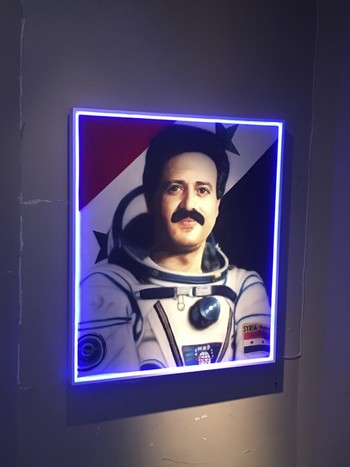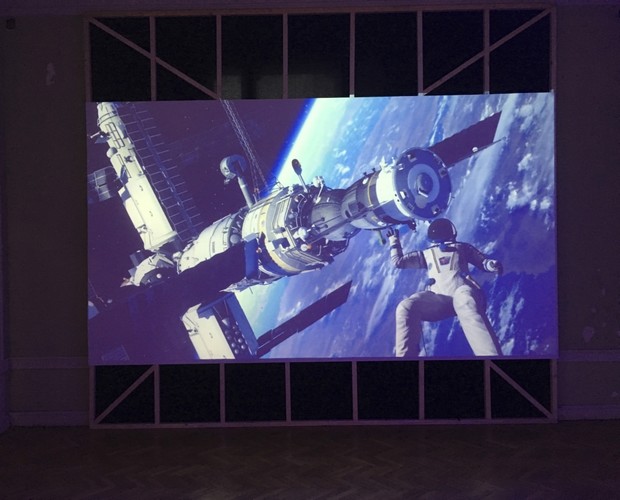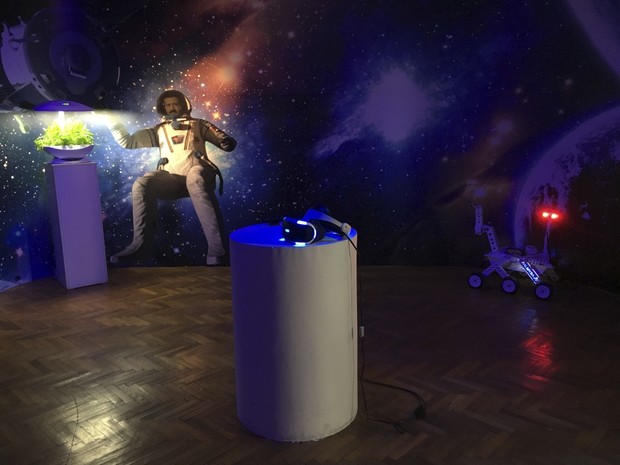© Turkuvaz Haberleşme ve Yayıncılık 2026
Curated by the DAS Art Project, Pilot Gallery is hosting the solo show, "Welcome to Homeland" by distinguished artist Halil Altındere at the historic Sadık Pasha Mansion in Istanbul's Cihangir neighborhood, which includes various media works in painting, virtual reality (VR), videography and photography. Altındere's latest pieces, featured in the exhibition, focus on the refugee crisis of the region and can be viewed until Oct. 21.
The exhibit welcomes guests to a room of the gallery that features a large display of framed paintings decorated with neon lights, depicting images of Syrian astronaut Muhammed Ahmed Faris who traveled to space for seven days in 1987 and, as a result of the civil war in Syria, came to Istanbul as a refugee in 2012. The former astronaut was known as a national hero in his native country in 1987 and thereafter, going on to become one of the voices of the opposition and speaking out against the tyranny and dictatorship of the Assad regime in Syria.

After raising his voice during the uprising in Syria, the astronaut who had been regarded as a national hero, and had a street named after him, was labeled as a traitor in the eyes of the Assad regime and the street that had been named after him was renamed, amid the regime's attempts to strip him of his success. As a result of this, Faris and his family fled Syria in order to survive. If you happened to visit Syria before the civil war, you likely noticed the photographs and paintings of Hafız Assad and his son Bashar Assad on every street corner in the country. Altındere's paintings reminded me of that "image" from Syria but portray Faris as the rightful hero and protagonist.
As an obvious clue for what the rest of the exhibition holds, Ahmed Faris is at the center of it. In addition to the room devoted to paintings, "Welcome to Homeland" continues with other mediums on display, including a three-cosmonaut costume - one for adults and two for kids - with a 3D printed miniature toy sculpture by Ahmed Faris featured as well. Altındere's practice contains lots of sense of humor, which isn't seen recently, however, especially with this toy somehow it makes a contradiction with the monumental sculptures of the Assad family in Syria. As if saying that, "we can be small but stronger than you."

In the last room of the exhibition on the first floor of the gallery, there is a VR and the 2016 video "Journey to Mars" which depicts Mars as a utopic place devoid of hierarchy, dictatorship or borders: A more suitable territory for refugees. Unfortunately, there were some technical problems with the VR glasses therefore it wasn't easy to watch the video. In the VR experience you encounter a man and two children walking in a desolate environment in which they appear to be looking for shelter and a new home. On the other side of the VR, there is a documentary "Space Refugee," created in 2016, that tells Ahmed Faris's life story. The documentary aims to answer the following questions: How did the Faris family end up in Istanbul? What is the former astronaut doing now? And, what is the nature of his struggle? The video is an essential part of this exhibition as it provides understanding of the situation in Syria and veers away from the mainstream images shown of the region.
"Journey to Mars" focuses on the refugee crisis, explained from Faris's point of view. The former astronaut offers us a fresh point of view on the subject, as we have all had enough of the images that contain violence and our emotions have been consumed by the overwhelming images that have seemingly taken over social media and mainstream media alike. The artist discusses displacement as a concept and draws a line between reterritorialization and the decontextualization of it and offers us a new reality, in a utopic territory that no one can own it and its reality is melting onto fiction with its image.

My first encounter with this exhibition was in 2016, during the Berlin Biennial. In the rap video clip "Homeland," Syrian rapper Mohammad Abu Hajar mixes realism and fiction with VFX, drones and borders. Abu Hajar is becoming a sort of protagonist in the drama unfolding in Syria, helping refugees to cross European borders to reach the Tempelhof Refugee Center- a former airport in the heart of Berlin.
Altındere's work was placed on exhibit at Akademie Der Künste during the 2016 Berlin Biennale, which is on PariserPlatz in Berlin. Homeland's direction was toward the Branderburger Tor (Branderburger Gate), which was one of the borders between East and West Germany from 1961 to 1989 and the gate became a symbol of freedom and the desire to unify the city of Berlin and EU after Berlin Wall fell. In the context of the Berlin exhibition, I find the video quite fitting because of its indirect and direct references to the history of the region. Altındere was slapping the EU's border policy against their face toward the refugees in the heart of Europe. Altındere's work was one of the strongest works together with Hito Steyerl in the controversial Berlin Biennale.
The presentation of Abu Hajar's rap video clip at the Istanbul exhibition is quite different. At the Sadık Pasha Mansion, shown on a TV screen rather than a wall projection, I believe that this causes the focus of the video to be lost, compared to other presentations. Although the environment of this exhibit is entirely different, it had an impact on me like the previous exhibit in Berlin.
The video raises questions about displacement, transportation, forced migration and the longing for one's homeland that has been left behind. Altındere's artistic perspective in the Istanbul exhibition is quite unique because the relation that he chose to build up with his subject is considerably equal. I believe this form of relation is feeding itself from Altındere's diverse background.
